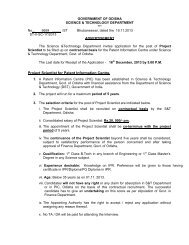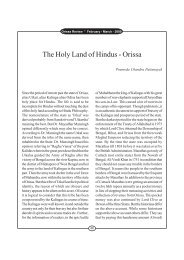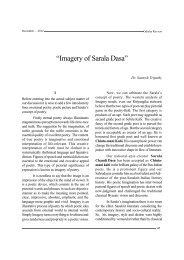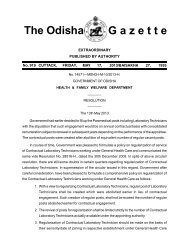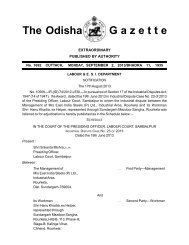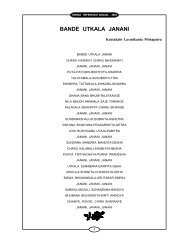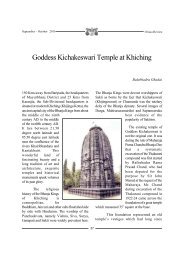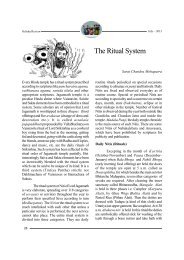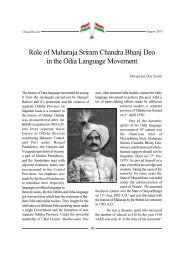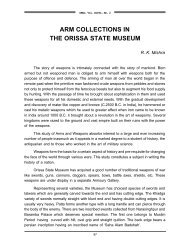Durga temple at Kudapatna : A Study on Art and Architecture
Durga temple at Kudapatna : A Study on Art and Architecture
Durga temple at Kudapatna : A Study on Art and Architecture
Create successful ePaper yourself
Turn your PDF publications into a flip-book with our unique Google optimized e-Paper software.
October - 2012<br />
Introducti<strong>on</strong><br />
<str<strong>on</strong>g>Durga</str<strong>on</strong>g> <str<strong>on</strong>g>temple</str<strong>on</strong>g> <str<strong>on</strong>g>at</str<strong>on</strong>g> Kudap<str<strong>on</strong>g>at</str<strong>on</strong>g>na : A <str<strong>on</strong>g>Study</str<strong>on</strong>g> <strong>on</strong><br />
<strong>Art</strong> <strong>and</strong> <strong>Architecture</strong><br />
The <str<strong>on</strong>g>Durga</str<strong>on</strong>g> <str<strong>on</strong>g>temple</str<strong>on</strong>g> of Kudap<str<strong>on</strong>g>at</str<strong>on</strong>g>na is <strong>on</strong>e of the<br />
important Sakta shrines of the Prachi Valley. It is<br />
loc<str<strong>on</strong>g>at</str<strong>on</strong>g>ed <str<strong>on</strong>g>at</str<strong>on</strong>g> the village Kudap<str<strong>on</strong>g>at</str<strong>on</strong>g>na in the Balip<str<strong>on</strong>g>at</str<strong>on</strong>g>na<br />
Block of the Khurda district. The <str<strong>on</strong>g>temple</str<strong>on</strong>g> is situ<str<strong>on</strong>g>at</str<strong>on</strong>g>ed<br />
about 5 km from Niali <strong>on</strong> the left bank of the<br />
river Prachi. 1 It is built <strong>on</strong> the ruins of the earlier<br />
th<str<strong>on</strong>g>at</str<strong>on</strong>g>ched <str<strong>on</strong>g>temple</str<strong>on</strong>g>. The original <str<strong>on</strong>g>temple</str<strong>on</strong>g> of Barabhuja<br />
<str<strong>on</strong>g>Durga</str<strong>on</strong>g> was a brick m<strong>on</strong>ument of the Prachi valley. 2<br />
The local people say th<str<strong>on</strong>g>at</str<strong>on</strong>g> the present <str<strong>on</strong>g>temple</str<strong>on</strong>g> has<br />
been repaired in 1980 , s by the co-oper<str<strong>on</strong>g>at</str<strong>on</strong>g>i<strong>on</strong> of<br />
the villagers. So it is completely a renov<str<strong>on</strong>g>at</str<strong>on</strong>g>ed <str<strong>on</strong>g>temple</str<strong>on</strong>g><br />
of th<str<strong>on</strong>g>at</str<strong>on</strong>g> locality. The <str<strong>on</strong>g>temple</str<strong>on</strong>g> c<strong>on</strong>sists of two<br />
structures such as vimana <strong>and</strong> jagamohana. It<br />
is built in s<strong>and</strong> st<strong>on</strong>es <strong>and</strong> bricks. This <str<strong>on</strong>g>temple</str<strong>on</strong>g> faces<br />
to east. Besides the main <str<strong>on</strong>g>temple</str<strong>on</strong>g>, two additi<strong>on</strong>al<br />
shrines are also erected inside the <str<strong>on</strong>g>temple</str<strong>on</strong>g><br />
complex. They are viz; <strong>on</strong>e is Bhabakundalesvara<br />
Siva <strong>and</strong> another shrine is of Lord Narasimha.<br />
The presence of Lord Siva <strong>and</strong> Lord Narasimha<br />
in the <str<strong>on</strong>g>temple</str<strong>on</strong>g> complex suggests th<str<strong>on</strong>g>at</str<strong>on</strong>g> the <str<strong>on</strong>g>temple</str<strong>on</strong>g><br />
site is a co-ordin<str<strong>on</strong>g>at</str<strong>on</strong>g>ing place of Saktism, Saivism<br />
<strong>and</strong> Vaishnavism. Really, the Prachi valley is<br />
affluent with <str<strong>on</strong>g>Durga</str<strong>on</strong>g> images all around. <str<strong>on</strong>g>Durga</str<strong>on</strong>g><br />
images of two h<strong>and</strong>ed to twelve h<strong>and</strong>ed speak<br />
about the evoluti<strong>on</strong> of <str<strong>on</strong>g>Durga</str<strong>on</strong>g> cult in Odisha. 3 These<br />
images are from the Pre-Gupta period to the 16 th -<br />
17 th century A.D. 4 Am<strong>on</strong>g all the extant <str<strong>on</strong>g>Durga</str<strong>on</strong>g><br />
images of the Prachi valley, the twelve h<strong>and</strong>ed<br />
Odisha Review<br />
Dr. R<str<strong>on</strong>g>at</str<strong>on</strong>g>nakar Mohap<str<strong>on</strong>g>at</str<strong>on</strong>g>ra<br />
Kanhu Meher<br />
image of Mahisamarddini <str<strong>on</strong>g>Durga</str<strong>on</strong>g> of Kudap<str<strong>on</strong>g>at</str<strong>on</strong>g>na is<br />
a unique image from the ic<strong>on</strong>ographical point of<br />
view. 5 A modest <str<strong>on</strong>g>at</str<strong>on</strong>g>tempt has been made in this<br />
article to highlight the detailed art <strong>and</strong> architecture<br />
of the <str<strong>on</strong>g>Durga</str<strong>on</strong>g> <str<strong>on</strong>g>temple</str<strong>on</strong>g> of Kudap<str<strong>on</strong>g>at</str<strong>on</strong>g>na.<br />
<strong>Art</strong> <strong>and</strong> <strong>Architecture</strong> of the Temple<br />
A. Vimana :<br />
The vimana of the <str<strong>on</strong>g>temple</str<strong>on</strong>g> is a pidha<br />
deula <strong>and</strong> its height is about 25 feet from the<br />
surface of the <str<strong>on</strong>g>temple</str<strong>on</strong>g> complex. 6 It has four fold<br />
divisi<strong>on</strong>s such as pistha, bada, g<strong>and</strong>i <strong>and</strong><br />
mastaka. The pistha is about 2 feet high from<br />
the surface of the <str<strong>on</strong>g>temple</str<strong>on</strong>g> complex. The bada is<br />
panchanga type i.e. having five fold divisi<strong>on</strong>s<br />
such as pabhaga, tala jangha, b<strong>and</strong>hana,<br />
23
Odisha Review October - 2012<br />
upper jangha <strong>and</strong> bar<strong>and</strong>a. All the comp<strong>on</strong>ent<br />
parts of the bada are devoid of sculptural<br />
embellishments.<br />
The central niches of the three sides of<br />
the bada are housed with the parsva dev<str<strong>on</strong>g>at</str<strong>on</strong>g>a<br />
images of Maha-Vairabhi, Maha-Sarasv<str<strong>on</strong>g>at</str<strong>on</strong>g>i <strong>and</strong><br />
Narayani. All the side deities are housed in the<br />
nisha garbhakas (shrines), which are built in<br />
same designs <strong>and</strong> height. Each nisha shrine is<br />
pidha order <strong>and</strong> it is about 15 feet high from the<br />
surface of the <str<strong>on</strong>g>temple</str<strong>on</strong>g> complex. The local devotees<br />
have housed these parsva<br />
dev<str<strong>on</strong>g>at</str<strong>on</strong>g>as of the <str<strong>on</strong>g>temple</str<strong>on</strong>g> in<br />
1990 , s. Maha-Vairabhi is the<br />
parsva dev<str<strong>on</strong>g>at</str<strong>on</strong>g>a of the<br />
southern side. The four armed<br />
image of Maha-Vairabhi is<br />
carved in lalitasana pose <strong>on</strong><br />
the double petalled lotus<br />
pedestal. She displays<br />
khadga in upper right h<strong>and</strong>,<br />
abhaya mudra in lower right<br />
h<strong>and</strong>, pana p<str<strong>on</strong>g>at</str<strong>on</strong>g>ra in upper<br />
left h<strong>and</strong> <strong>and</strong> the lower left<br />
h<strong>and</strong> possesses a chhinna<br />
mastaka. The backside of<br />
the head of Devi Vairabhi is<br />
decor<str<strong>on</strong>g>at</str<strong>on</strong>g>ed with a<br />
prabham<strong>and</strong>ala, which is<br />
designed in full blown lotus<br />
flower. The image Maha Vairabhi is made of<br />
chlorite st<strong>on</strong>e. It measures 11 inches in width <strong>and</strong><br />
1 foot 5 inches in height respectively. Maha-<br />
Sarasv<str<strong>on</strong>g>at</str<strong>on</strong>g>i is the parsva dev<str<strong>on</strong>g>at</str<strong>on</strong>g>a of the western<br />
side. The four armed image of Maha-Sarasv<str<strong>on</strong>g>at</str<strong>on</strong>g>i is<br />
carved in lalitasana pose <strong>on</strong> the single petalled<br />
lotus pedestal. She displays a circular indistinct<br />
object in upper right h<strong>and</strong>, abhaya mudra with<br />
rosary in lower right h<strong>and</strong>, a full blown lotus in<br />
upper left h<strong>and</strong> <strong>and</strong> varada mudra with lekhani<br />
in lower left h<strong>and</strong> respectively. The backside of<br />
24<br />
the head of Devi Maha-Sarasv<str<strong>on</strong>g>at</str<strong>on</strong>g>i is carved with<br />
a prabham<strong>and</strong>ala, which is designed by lotus<br />
petals. The image Maha- Sarasv<str<strong>on</strong>g>at</str<strong>on</strong>g>i is made of<br />
chlorite st<strong>on</strong>e. It measures 1 foot 5 inches in height<br />
<strong>and</strong> 11 inches in width. Goddess Narayani is the<br />
parsva dev<str<strong>on</strong>g>at</str<strong>on</strong>g>a of the northern side. The four<br />
armed image of Narayani is carved in lalitasana<br />
pose <strong>on</strong> the double petalled lotus pedestal. One<br />
of Her legs has kept <strong>on</strong> the pedestal <strong>and</strong> another<br />
leg is pendent. She holds lotus flower in upper<br />
right h<strong>and</strong>, lotus bud in lower right h<strong>and</strong>, shankha<br />
in upper left h<strong>and</strong> <strong>and</strong> gada<br />
in lower left h<strong>and</strong> respectively.<br />
The backside of the head of<br />
Devi Narayani is carved with<br />
a prabham<strong>and</strong>ala, which is<br />
decor<str<strong>on</strong>g>at</str<strong>on</strong>g>ed with lotus petals.<br />
The image Narayani is made<br />
of chlorite st<strong>on</strong>e. The image<br />
Narayani measures 1 foot 5<br />
inches in height <strong>and</strong> 11 inches<br />
in width respectively. This<br />
Goddess is being<br />
worshipped by the local<br />
people as Maha-Kali. Here<br />
B.K. R<str<strong>on</strong>g>at</str<strong>on</strong>g>ha refers to an image<br />
of Ambika in the side niche<br />
of the <str<strong>on</strong>g>temple</str<strong>on</strong>g>. 7 Now this<br />
Ambika image is not found<br />
preserved in the <str<strong>on</strong>g>temple</str<strong>on</strong>g><br />
premises.<br />
The g<strong>and</strong>i of the vimana is a pyramidal<br />
superstructure. It c<strong>on</strong>sists of two potalas, the<br />
lower <strong>and</strong> upper, which c<strong>on</strong>tain 4 <strong>and</strong> 3 pidhas<br />
respectively. Each pidha is decor<str<strong>on</strong>g>at</str<strong>on</strong>g>ed with tankus<br />
in all sides. The centre of the upper pidha of the<br />
lower potala is decor<str<strong>on</strong>g>at</str<strong>on</strong>g>ed with pidha mastaka<br />
designs in three sides except the fr<strong>on</strong>t. A large<br />
sized pidha mastaka design is decor<str<strong>on</strong>g>at</str<strong>on</strong>g>ed <str<strong>on</strong>g>at</str<strong>on</strong>g> the<br />
centre of the fr<strong>on</strong>t side raha paga of the g<strong>and</strong>i.<br />
Deula Charini figures <strong>and</strong> dopichha li<strong>on</strong>s are
October - 2012<br />
completely absent in their respective places above<br />
the g<strong>and</strong>i. The entire structure of the vimana is<br />
plastered with modern cement.<br />
The mastaka of the vimana c<strong>on</strong>sists of<br />
beki, ghanta, above which there is another beki,<br />
sila, khapuri, kalasa, ayudha (chakra) <strong>and</strong><br />
dhvaja. The sanctum preserves the large sized<br />
image of Goddess <str<strong>on</strong>g>Durga</str<strong>on</strong>g> as the presiding deity<br />
of the <str<strong>on</strong>g>temple</str<strong>on</strong>g>. The twelve armed image of<br />
Goddess <str<strong>on</strong>g>Durga</str<strong>on</strong>g> is carved in ugra posture <strong>on</strong> the<br />
plain pedestal. She is piercing into the neck of<br />
Mahisasura by a trident. Li<strong>on</strong>, the c<strong>on</strong>venti<strong>on</strong>al<br />
mount of Goddess <str<strong>on</strong>g>Durga</str<strong>on</strong>g> is carved <strong>on</strong> the right<br />
of the pedestal. Mahisasura, the dem<strong>on</strong> is<br />
depicted <strong>on</strong> the pedestal of the slab. The right<br />
side six h<strong>and</strong>s of Goddess <str<strong>on</strong>g>Durga</str<strong>on</strong>g> display khadga,<br />
lotus, trident, varada mudra, an indistinct object<br />
<strong>and</strong> the backside h<strong>and</strong> is empty. The left side six<br />
h<strong>and</strong>s hold shield, gada, bow, bell, snake <strong>and</strong><br />
the backside h<strong>and</strong> is blank. The image <str<strong>on</strong>g>Durga</str<strong>on</strong>g> is<br />
made of chlorite st<strong>on</strong>e. It measures 5 feet 5 inches<br />
in height <strong>and</strong> 2 feet 3 inches in width. This image<br />
is a unique sculpture of the Prachi Valley in the<br />
coastal-belt of Odisha. Observing the<br />
ic<strong>on</strong>ography of the presiding deity, Hansan<str<strong>on</strong>g>at</str<strong>on</strong>g>ha<br />
Sahoo remarks th<str<strong>on</strong>g>at</str<strong>on</strong>g> the image is an art of the<br />
Bhaumakara period. 8 Another st<strong>on</strong>e image of eight<br />
armed Goddess <str<strong>on</strong>g>Durga</str<strong>on</strong>g> is also found worshipped<br />
<strong>on</strong> the left side of the presiding deity. The eight<br />
armed image of Goddess <str<strong>on</strong>g>Durga</str<strong>on</strong>g> is carved in<br />
st<strong>and</strong>ing posture <strong>on</strong> the pedestal. This image is<br />
made of chlorite st<strong>on</strong>e. The right side h<strong>and</strong>s of<br />
Devi display khadga, trident, lotus or c<strong>on</strong>ch <strong>and</strong><br />
chakra while the left side four h<strong>and</strong>s hold rosary,<br />
bow, snake <strong>and</strong> <strong>on</strong>e h<strong>and</strong> holds the hair of<br />
Mahisasura. Li<strong>on</strong>, the c<strong>on</strong>venti<strong>on</strong>al mount of<br />
Devi is carved <strong>on</strong> the right of the pedestal. The<br />
Mahisasura figure is depicted <strong>on</strong> the pedestal.<br />
The image astabhuja <str<strong>on</strong>g>Durga</str<strong>on</strong>g> measures 3 feet 4<br />
inches in height <strong>and</strong> 1 foot 10 inches in width.<br />
Observing this <str<strong>on</strong>g>Durga</str<strong>on</strong>g> image, H.N. Sahoo remarks<br />
Odisha Review<br />
th<str<strong>on</strong>g>at</str<strong>on</strong>g> the <str<strong>on</strong>g>at</str<strong>on</strong>g>tributes of c<strong>on</strong>ch <strong>and</strong> chakra with the<br />
upper h<strong>and</strong>s <strong>and</strong> the lower right h<strong>and</strong> holds a<br />
trident <strong>and</strong> the left h<strong>and</strong> drags the hair of the<br />
dem<strong>on</strong> is known as <str<strong>on</strong>g>Durga</str<strong>on</strong>g>-Madhava. 9 Besides,<br />
there is a brass image of Mahisamarddini <str<strong>on</strong>g>Durga</str<strong>on</strong>g><br />
also found <strong>on</strong> the right side of the presiding deity.<br />
This image is c<strong>on</strong>sidered as the chalanti pr<str<strong>on</strong>g>at</str<strong>on</strong>g>ima<br />
of the presiding deity. The image presiding deity<br />
is adorned with the makara headed arch<br />
supported by the pillar <strong>on</strong> each side. The presiding<br />
deity is installed <strong>on</strong> the simhasana of 2 feet high.<br />
The sanctum has <strong>on</strong>e doorway towards<br />
the jagamohana hall. Gaja-Lakshmi image is<br />
carved in abhiseka pose <strong>on</strong> the centre of the<br />
doorway lintel. Navagrahas are carved in<br />
st<strong>and</strong>ing posture <strong>on</strong> the architrave above the<br />
doorway lintel. They are depicted with as usual<br />
<str<strong>on</strong>g>at</str<strong>on</strong>g>tributes in their h<strong>and</strong>s. The right side base of<br />
the doorframe is inserted with a st<strong>on</strong>e slab<br />
c<strong>on</strong>taining an image of Trivikrama.<br />
In the right side doorway wall of the<br />
sanctum is inserted with an image of Ganesha.<br />
The four armed image of Ganesha is carved in<br />
dancing posture <strong>on</strong> the back of mouse. He<br />
displays broken tusk in upper right h<strong>and</strong>, rosary<br />
in lower right h<strong>and</strong>, a pot of ladus in upper left<br />
h<strong>and</strong> <strong>and</strong> parashu (h<str<strong>on</strong>g>at</str<strong>on</strong>g>chet) in lower left h<strong>and</strong><br />
respectively. The image Ganesha is made of<br />
chlorite st<strong>on</strong>e. The backside of the head of the<br />
deity is decor<str<strong>on</strong>g>at</str<strong>on</strong>g>ed with prabham<strong>and</strong>ala, which<br />
is designed with lotus petals. The image Ganesha<br />
measures 2 feet in height <strong>and</strong> 1 foot 2 inches in<br />
width. This image is built in the last quarter of the<br />
twentieth century. The left side doorway wall of<br />
the sanctum is fixed with an image of Karttikeya.<br />
The four armed image of Karttikeya is carved in<br />
st<strong>and</strong>ing posture <strong>on</strong> the double secti<strong>on</strong>al pedestal.<br />
Peacock, the c<strong>on</strong>venti<strong>on</strong>al mount of the deity is<br />
carved <strong>on</strong> the right of the pedestal. The lower<br />
part of the pedestal is decor<str<strong>on</strong>g>at</str<strong>on</strong>g>ed with lotus petals.<br />
25
Odisha Review October - 2012<br />
He displays trident in upper right h<strong>and</strong>, abhaya<br />
mudra in lower right h<strong>and</strong>, sankha in upper left<br />
h<strong>and</strong> <strong>and</strong> bow in lower left h<strong>and</strong> respectively. The<br />
backside of the head of deity is decor<str<strong>on</strong>g>at</str<strong>on</strong>g>ed with<br />
prabham<strong>and</strong>ala. The image Karttikeya is made<br />
of chlorite st<strong>on</strong>e. It is about 2 feet in height.<br />
B. Jagamohana :<br />
The jagamohana of the <str<strong>on</strong>g>temple</str<strong>on</strong>g> is a fl<str<strong>on</strong>g>at</str<strong>on</strong>g><br />
roof structure <strong>and</strong> its height is about 13 feet from<br />
the surface of the <str<strong>on</strong>g>temple</str<strong>on</strong>g> complex. It has been<br />
built in 2008. The structure of the jagamohana<br />
has four open doorways, two <strong>on</strong> the southern side<br />
<strong>and</strong> <strong>on</strong>e <strong>on</strong> each side of the east <strong>and</strong> north<br />
respectively.<br />
Li<strong>on</strong>, the c<strong>on</strong>venti<strong>on</strong>al mount of Goddess<br />
<str<strong>on</strong>g>Durga</str<strong>on</strong>g> is installed <str<strong>on</strong>g>at</str<strong>on</strong>g> the centre of the jagamohana<br />
hall. Inner walls of the jagamohana are<br />
completely plain <strong>and</strong> are recently covered with<br />
glazed tiles. Two li<strong>on</strong> figures are installed <strong>on</strong> both<br />
sides of the eastern doorway. They are acting as<br />
the dvarapalas of the <str<strong>on</strong>g>temple</str<strong>on</strong>g>.<br />
Additi<strong>on</strong>al Shrines<br />
Besides the main <str<strong>on</strong>g>temple</str<strong>on</strong>g>, there are two<br />
additi<strong>on</strong>al shrines also noticed inside the <str<strong>on</strong>g>temple</str<strong>on</strong>g><br />
complex. They are the shrines of<br />
Bhabakundalesvara Siva <strong>and</strong> Lord Narasimha.<br />
A. Shrine of Bhabakundalesvara :<br />
In the north-east corner of the <str<strong>on</strong>g>temple</str<strong>on</strong>g><br />
complex is occupied by a Saiva shrine, which is<br />
dedic<str<strong>on</strong>g>at</str<strong>on</strong>g>ed to Lord Bhabakundalesvara Siva. The<br />
shrine is a pidha order structure <strong>and</strong> it is about<br />
18 feet high from the surface of the <str<strong>on</strong>g>temple</str<strong>on</strong>g><br />
complex.<br />
The central niches of the three sides of<br />
the bada of the additi<strong>on</strong>al shrine are housed with<br />
the parsva dev<str<strong>on</strong>g>at</str<strong>on</strong>g>a images of Ganesha, Karttikeya<br />
<strong>and</strong> Devi Parv<str<strong>on</strong>g>at</str<strong>on</strong>g>i. Ganesha is the parsva dev<str<strong>on</strong>g>at</str<strong>on</strong>g>a<br />
of the southern side. The four armed image of<br />
26<br />
Ganesha is carved in ardha paryanka pose <strong>on</strong><br />
the pedestal. He displays parasu in upper right<br />
h<strong>and</strong>, rosary in lower right h<strong>and</strong>, broken tusk in<br />
upper left h<strong>and</strong> <strong>and</strong> the lower left h<strong>and</strong> touches<br />
his belly. The backside of the head of deity is<br />
decor<str<strong>on</strong>g>at</str<strong>on</strong>g>ed with a prabham<strong>and</strong>ala. The image<br />
Ganesha is made of s<strong>and</strong> st<strong>on</strong>e. The lower part<br />
of the pedestal is decor<str<strong>on</strong>g>at</str<strong>on</strong>g>ed with kalasa,<br />
dhupadani, etc. The image Ganesha measures 3<br />
feet 5 inches in height <strong>and</strong> 1 foot 10 inches in<br />
width respectively. Karttikeya is the parsva<br />
dev<str<strong>on</strong>g>at</str<strong>on</strong>g>a of the eastern side. The two armed image<br />
of Karttikeya is carved in lalitasana pose <strong>on</strong> the<br />
pedestal. He holds dagger in right h<strong>and</strong> <strong>and</strong> the<br />
left h<strong>and</strong> lies <strong>on</strong> his secret organ. Peacock, the<br />
c<strong>on</strong>venti<strong>on</strong>al mount of the deity is not found carved<br />
<strong>on</strong> the pedestal. The image Karttikeya is made of<br />
s<strong>and</strong> st<strong>on</strong>e. It measures 3 feet in height <strong>and</strong> 1<br />
foot 9 inches in width respectively. Devi Parv<str<strong>on</strong>g>at</str<strong>on</strong>g>i<br />
is the parsva dev<str<strong>on</strong>g>at</str<strong>on</strong>g>a of the northern side. The<br />
four armed image of Devi Parv<str<strong>on</strong>g>at</str<strong>on</strong>g>i is carved in<br />
st<strong>and</strong>ing posture <strong>on</strong> the double petalled lotus<br />
pedestal. The bottom part of the pedestal is<br />
decor<str<strong>on</strong>g>at</str<strong>on</strong>g>ed with scroll work. Li<strong>on</strong>, the c<strong>on</strong>venti<strong>on</strong>al<br />
mount of Devi Parv<str<strong>on</strong>g>at</str<strong>on</strong>g>i is carved <strong>on</strong> the right of<br />
the pedestal. Female sakhi figures are carved <strong>on</strong><br />
both sides of Devi Parv<str<strong>on</strong>g>at</str<strong>on</strong>g>i. She holds nagapasa<br />
in upper right h<strong>and</strong>, rosary in lower right h<strong>and</strong>,<br />
ankusa in upper left h<strong>and</strong> <strong>and</strong> stalk of a lotus<br />
flower in lower left h<strong>and</strong> respectively. The<br />
backside of the head of Devi Parv<str<strong>on</strong>g>at</str<strong>on</strong>g>i is decor<str<strong>on</strong>g>at</str<strong>on</strong>g>ed<br />
with trefoil arch, makara head <str<strong>on</strong>g>at</str<strong>on</strong>g> the base <strong>and</strong><br />
the kirtimukha motif <str<strong>on</strong>g>at</str<strong>on</strong>g> the apex. Apsara figure<br />
holding garl<strong>and</strong> is depicted <strong>on</strong> both side top<br />
corners of the slab. The image Parv<str<strong>on</strong>g>at</str<strong>on</strong>g>i measures<br />
2 feet 6 inches in height <strong>and</strong> 1 foot 4 inches in<br />
width. It is made of chlorite st<strong>on</strong>e. All the parsva<br />
dev<str<strong>on</strong>g>at</str<strong>on</strong>g>as of the additi<strong>on</strong>al shrine are housed in the<br />
pidha mundi niches.<br />
The g<strong>and</strong>i of the additi<strong>on</strong>al shrine is a<br />
pyramidal superstructure. The mastaka of the
October - 2012<br />
shrine c<strong>on</strong>sists of beki, ghanta, amalakasila,<br />
khapuri, kalasa, ayudha (trident) <strong>and</strong> dhvaja.<br />
The sanctum preserves the Sivalingam<br />
within the Saktipitha as the presiding deity of th<str<strong>on</strong>g>at</str<strong>on</strong>g><br />
shrine. The floor of the sanctum is about 10 feet<br />
below the surface of the <str<strong>on</strong>g>temple</str<strong>on</strong>g><br />
complex. Mas<strong>on</strong>ry steps of the<br />
descending order are provided<br />
for approach towards the<br />
sanctum.<br />
According to the local<br />
people, this shrine is earlier than<br />
the present (renov<str<strong>on</strong>g>at</str<strong>on</strong>g>ed) <str<strong>on</strong>g>Durga</str<strong>on</strong>g><br />
<str<strong>on</strong>g>temple</str<strong>on</strong>g> of the complex. B. K.<br />
R<str<strong>on</strong>g>at</str<strong>on</strong>g>ha has menti<strong>on</strong>ed th<str<strong>on</strong>g>at</str<strong>on</strong>g> the<br />
Bhabakundalesvara shrine of<br />
the <str<strong>on</strong>g>temple</str<strong>on</strong>g> complex bel<strong>on</strong>gs to<br />
the twentieth century. 10 On the<br />
basis of the ic<strong>on</strong>ographical<br />
fe<str<strong>on</strong>g>at</str<strong>on</strong>g>ures of the parsva dev<str<strong>on</strong>g>at</str<strong>on</strong>g>as<br />
(of the shrine), the c<strong>on</strong>structi<strong>on</strong><br />
period of the<br />
Bhabakundalesvara shrine is<br />
earlier than the present<br />
renov<str<strong>on</strong>g>at</str<strong>on</strong>g>ed <str<strong>on</strong>g>Durga</str<strong>on</strong>g> <str<strong>on</strong>g>temple</str<strong>on</strong>g> of the<br />
site.<br />
There is a jagamohana recently erected<br />
in fr<strong>on</strong>t of the additi<strong>on</strong>al shrine. Three bull figures<br />
are installed <strong>on</strong> the open floor before the<br />
jagamohana hall. They are being c<strong>on</strong>sidered as<br />
the vahanas of Lord Bhabakundalesvara Siva.<br />
B. Shrine of Narasimha<br />
There is another additi<strong>on</strong>al shrine recently<br />
erected in the south-west corner of the <str<strong>on</strong>g>temple</str<strong>on</strong>g><br />
complex. It is a pidha deula <strong>and</strong> is about 20 feet<br />
in height. The sanctum of the shrine preserves the<br />
image of Narasimha as the presiding deity. The<br />
four armed image of Narasimha is carved in<br />
st<strong>and</strong>ing posture <strong>on</strong> the lotus petal designed<br />
Odisha Review<br />
pedestal. He holds chakra in upper right h<strong>and</strong>,<br />
shankha in upper left h<strong>and</strong>. The lower two h<strong>and</strong>s<br />
of the deity are engaged to take out the entrails of<br />
Hiranya Kashyapa, the dem<strong>on</strong>. The backside of<br />
the head of deity is decor<str<strong>on</strong>g>at</str<strong>on</strong>g>ed with el<strong>on</strong>g<str<strong>on</strong>g>at</str<strong>on</strong>g>ed<br />
prabham<strong>and</strong>ala. The image<br />
Narasimha is made of chlorite<br />
st<strong>on</strong>e. It is built in the last<br />
quarter of the 20 th century. The<br />
doorway of the shrine is<br />
completely plain. The left side<br />
inner wall niche of the<br />
jagamohana is inserted with<br />
the Dasav<str<strong>on</strong>g>at</str<strong>on</strong>g>ara panel of Lord<br />
Vishnu while the right side wall<br />
c<strong>on</strong>tains the navagraha panel<br />
are made in the same period of<br />
the presiding deity.<br />
Recently, a<br />
n<str<strong>on</strong>g>at</str<strong>on</strong>g>am<strong>and</strong>apa is being erected<br />
by the village community.<br />
Garuda, the c<strong>on</strong>venti<strong>on</strong>al<br />
mount of the deity (Narasimha)<br />
is installed <strong>on</strong> the floor of the<br />
n<str<strong>on</strong>g>at</str<strong>on</strong>g>am<strong>and</strong>apa. Mahavir<br />
Hanumana figures are installed<br />
near the four g<str<strong>on</strong>g>at</str<strong>on</strong>g>eways of the <str<strong>on</strong>g>temple</str<strong>on</strong>g> complex.<br />
Boundary Wall :<br />
The <str<strong>on</strong>g>temple</str<strong>on</strong>g> complex is enclosed by a<br />
boundary wall, which is 6 feet in height. It is made<br />
of modern bricks. The <str<strong>on</strong>g>temple</str<strong>on</strong>g> complex has four<br />
entrances, <strong>on</strong>e <strong>on</strong> each cardinal directi<strong>on</strong> of the<br />
boundary wall.<br />
D<str<strong>on</strong>g>at</str<strong>on</strong>g>e of the Temple<br />
There is no authentic record with regard<br />
to the exact d<str<strong>on</strong>g>at</str<strong>on</strong>g>e of the original <str<strong>on</strong>g>temple</str<strong>on</strong>g> of<br />
Barabhuja Mahisamarddini <str<strong>on</strong>g>Durga</str<strong>on</strong>g> of<br />
Kudap<str<strong>on</strong>g>at</str<strong>on</strong>g>na. The local people say th<str<strong>on</strong>g>at</str<strong>on</strong>g> before the<br />
present <str<strong>on</strong>g>temple</str<strong>on</strong>g> there was a th<str<strong>on</strong>g>at</str<strong>on</strong>g>ched <str<strong>on</strong>g>temple</str<strong>on</strong>g> for<br />
27
Odisha Review October - 2012<br />
the Goddess <str<strong>on</strong>g>Durga</str<strong>on</strong>g>. Here Hansan<str<strong>on</strong>g>at</str<strong>on</strong>g>ha Sahoo, <strong>on</strong>e<br />
of the senior scholars of the Prachi Valley, is of<br />
the view th<str<strong>on</strong>g>at</str<strong>on</strong>g> the architectural <strong>and</strong> sculptural<br />
represent<str<strong>on</strong>g>at</str<strong>on</strong>g>i<strong>on</strong> brings back to 6 th -7 th century<br />
A.D. 11 Original brick <str<strong>on</strong>g>temple</str<strong>on</strong>g> of Goddess <str<strong>on</strong>g>Durga</str<strong>on</strong>g><br />
was completely destroyed by n<str<strong>on</strong>g>at</str<strong>on</strong>g>ure. Thereafter,<br />
a th<str<strong>on</strong>g>at</str<strong>on</strong>g>ched <str<strong>on</strong>g>temple</str<strong>on</strong>g> was rebuilt <strong>on</strong> the ruins of the<br />
earlier <strong>on</strong>e for worship of Goddess <str<strong>on</strong>g>Durga</str<strong>on</strong>g>. B.K.<br />
R<str<strong>on</strong>g>at</str<strong>on</strong>g>ha menti<strong>on</strong>s th<str<strong>on</strong>g>at</str<strong>on</strong>g> the <str<strong>on</strong>g>temple</str<strong>on</strong>g> of Barabhuja<br />
<str<strong>on</strong>g>Durga</str<strong>on</strong>g> was built in the eighteenth century A.D. 12<br />
The original (earlier) <str<strong>on</strong>g>temple</str<strong>on</strong>g> of Barabhuja <str<strong>on</strong>g>Durga</str<strong>on</strong>g><br />
may be assignable to the l<str<strong>on</strong>g>at</str<strong>on</strong>g>er part of the<br />
Somavamsi period or early part of the Ganga<br />
period. The earlier th<str<strong>on</strong>g>at</str<strong>on</strong>g>ched <str<strong>on</strong>g>temple</str<strong>on</strong>g> has been<br />
completely renov<str<strong>on</strong>g>at</str<strong>on</strong>g>ed in 1980's by the cooper<str<strong>on</strong>g>at</str<strong>on</strong>g>i<strong>on</strong><br />
of the villagers.<br />
Now the <str<strong>on</strong>g>temple</str<strong>on</strong>g> is being managed by the<br />
P<strong>and</strong>a family of th<str<strong>on</strong>g>at</str<strong>on</strong>g> village.<br />
C<strong>on</strong>clusi<strong>on</strong><br />
Thus, it is known from the above<br />
discussi<strong>on</strong> th<str<strong>on</strong>g>at</str<strong>on</strong>g> the <str<strong>on</strong>g>Durga</str<strong>on</strong>g> <str<strong>on</strong>g>temple</str<strong>on</strong>g> of Kudap<str<strong>on</strong>g>at</str<strong>on</strong>g>na is<br />
an ancient Sakta shrine of the Prachi valley. The<br />
present <str<strong>on</strong>g>Durga</str<strong>on</strong>g> <str<strong>on</strong>g>temple</str<strong>on</strong>g> is erected <strong>on</strong> the earlier<br />
dilapid<str<strong>on</strong>g>at</str<strong>on</strong>g>ed th<str<strong>on</strong>g>at</str<strong>on</strong>g>ched shrine of th<str<strong>on</strong>g>at</str<strong>on</strong>g> site. The original<br />
side deities of the main <str<strong>on</strong>g>temple</str<strong>on</strong>g> are not found in<br />
the <str<strong>on</strong>g>temple</str<strong>on</strong>g> premises. The present parsva dev<str<strong>on</strong>g>at</str<strong>on</strong>g>as<br />
of the <str<strong>on</strong>g>temple</str<strong>on</strong>g> are of the last quarter of the twentieth<br />
century. The ic<strong>on</strong>ographic fe<str<strong>on</strong>g>at</str<strong>on</strong>g>ure of the presiding<br />
deity of the <str<strong>on</strong>g>temple</str<strong>on</strong>g> is a unique am<strong>on</strong>g all the extant<br />
<str<strong>on</strong>g>Durga</str<strong>on</strong>g> images of the Prachi valley. The additi<strong>on</strong>al<br />
shrine of Bhabakundalesvara inside the <str<strong>on</strong>g>temple</str<strong>on</strong>g><br />
complex suggests th<str<strong>on</strong>g>at</str<strong>on</strong>g> the original ruined <str<strong>on</strong>g>temple</str<strong>on</strong>g><br />
of the Goddess <str<strong>on</strong>g>Durga</str<strong>on</strong>g> of the site must have been<br />
earlier than the present additi<strong>on</strong>al shrine of Lord<br />
Bhabakundalesvara. The presence of Narasimha<br />
shrine in the <str<strong>on</strong>g>temple</str<strong>on</strong>g> complex remind us th<str<strong>on</strong>g>at</str<strong>on</strong>g> the<br />
site of the <str<strong>on</strong>g>temple</str<strong>on</strong>g> is a coordin<str<strong>on</strong>g>at</str<strong>on</strong>g>ing place of<br />
Saktism, Saivism <strong>and</strong> Vaishnavism. It indic<str<strong>on</strong>g>at</str<strong>on</strong>g>es<br />
th<str<strong>on</strong>g>at</str<strong>on</strong>g> during the medieval period the Sakta cult in<br />
the Prachi valley was closely associ<str<strong>on</strong>g>at</str<strong>on</strong>g>ed with the<br />
28<br />
Saiva <strong>and</strong> Vaishnava faiths. From the religious<br />
point of view, the presiding deity (Barabhuja<br />
<str<strong>on</strong>g>Durga</str<strong>on</strong>g>) of the <str<strong>on</strong>g>temple</str<strong>on</strong>g> is well known in th<str<strong>on</strong>g>at</str<strong>on</strong>g> locality.<br />
C<strong>on</strong>sidering the sacredness of the site, the <str<strong>on</strong>g>Durga</str<strong>on</strong>g><br />
<str<strong>on</strong>g>temple</str<strong>on</strong>g> of Kudap<str<strong>on</strong>g>at</str<strong>on</strong>g>na can be regarded as <strong>on</strong>e of<br />
the important Sakta shrines of the Prachi valley in<br />
Odisha.<br />
References :<br />
1. R.P. Mohap<str<strong>on</strong>g>at</str<strong>on</strong>g>ra, Archaeology in Orissa (Sites <strong>and</strong><br />
M<strong>on</strong>uments), Vol. 1, New Delhi, 1986, p.28.<br />
2. P.K. Ray, Archaeology Survey Report Prachi<br />
Valley, Orissa St<str<strong>on</strong>g>at</str<strong>on</strong>g>e Archaeology, Bhubaneswar,<br />
1975, p.27.<br />
3. S.K. Mitra, “Incredible Prachi Valley:M<strong>on</strong>uments<br />
<strong>and</strong> Tourism possibilities”, in P.K. Pradhan (ed.),<br />
Incredible Prachi Valley : Its M<strong>on</strong>uments <strong>and</strong><br />
Tourism Possibilities, Cuttack, 2007, p.106.<br />
4. Ibid.<br />
5. R.P. Mohap<str<strong>on</strong>g>at</str<strong>on</strong>g>ra, op.cit., Vol.1, p.28.<br />
6. B.K. R<str<strong>on</strong>g>at</str<strong>on</strong>g>ha (ed.), The Forgotten M<strong>on</strong>uments of<br />
Orissa, Vol.3, New Delhi,1990, p.39.<br />
7. Ibid.<br />
8. H.N. Sahoo,” The Rare But Less known<br />
M<strong>on</strong>uments of Prachi valley”, in P.K Pradhan (ed.),<br />
Incredible Prachi valley : Its M<strong>on</strong>uments &<br />
Tourism Possibilities, Cuttack p.55.<br />
9. Ibid .<br />
10. B.K. R<str<strong>on</strong>g>at</str<strong>on</strong>g>ha (ed.), op.cit., Vol.3, pp.38-39.<br />
11. H.N.Sahoo, op.cit., p.55.<br />
12. K R<str<strong>on</strong>g>at</str<strong>on</strong>g>ha (ed.), op.cit., p.39.<br />
Dr. R<str<strong>on</strong>g>at</str<strong>on</strong>g>nakar Mohap<str<strong>on</strong>g>at</str<strong>on</strong>g>ra, ICHR Post.Doctoral Fellow,<br />
At/Po- Purusottampur, Via- Shree Baladevjew,<br />
Dist- Kendrapara-754212.<br />
Kanhu Meher, RGNF- Senior Research Fellow, P.G.<br />
Department of History, Sambalpur University,<br />
Jyotivihar, Burla-768019.



